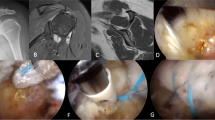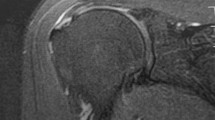Abstract
Purpose
We retrospectively evaluated the results of complete repair of massive potentially irreparable postero-superior tears in a consecutive cohort of patients. With the increasing and widespread use of superior capsular reconstruction, a complete repair of the superior cuff, also if not functional, may be a valuable option for irreparable cuff lesions.
Methods
A consecutive case series of massive potentially irreparable postero-superior cuff tears that underwent complete repair was included in the study. Irreparability of cuff tear was defined when on preoperative MRI images, a positive tangent sign, a Goutallier 3–4 stage of fatty infiltration, and an absent acromion–humeral distance were present. A single-row complete repair was performed using triple-loaded titanium suture anchors. Operative time was recorded, as well as intra- and postoperative complications. Patients were followed for 12 months post-op; they were clinically evaluated with the use of constant score (CS) and subjective shoulder value (SSV) at 3, 6, and 12 months; a 12-month postoperative ultrasound evaluation was obtained.
Results
Thirty-two patients satisfying the inclusion criteria were enrolled. The mean age was 52 years (range 41–58). The repair was completed with a mean use of 2.4 triple-loaded suture anchors (range 2–4); the mean operative time was 70 min (range 45–90). The mean preoperative CS was 55 (range 45–75, SD 17), while the SSV was 40 (range 30–70, SD 22). At the final follow-up, the mean CS and SSV were 72 (range 62–85, SD 8) and 80 (range 60–90, SD 10) (p < 0.001 with respect to the preoperative scores), respectively. At the final follow-up, sonography showed a complete healing of the cuff in 20 cases (62.5%). No intra-operative complications occurred; at the final follow-up, five patients (15, 6%) were not satisfied of the results and asked for revision surgery.
Conclusions
The complete repair of massive potentially irreparable rotator cuff tear in patients younger than 60 years old yielded good results at a short-term follow-up, with a sonographic re-tear rate of about 20%. Even if it is logical to consider a tendon with severe fatty degeneration as non-functional, the superior soft tissue reconstruction we achieved may have at least the same results of a superior capsular reconstruction, with obvious lower costs.
Level of evidence
Level 4, case series with no comparison group.




Similar content being viewed by others
References
Bedi A, Dines J, Warren RF, Dines DM (2010) Massive tears of the rotator cuff. J Bone Joint Surg Am 92:1894–1908. https://doi.org/10.2106/JBJS.I.01531
Elhassan B, Endres NK, Higgins LD, Warner JJ (2008) Massive irreparable tendon tears of the rotator cuff: salvageoptions. Instr Course Lect 57:153–166
Gerber C, Fuchs B, Hodler J (2000) The results of repair of massive tears of the rotator cuff. J Bone Joint Surg Am 82:505–515
Warner JJ, Parsons IM 4th (2001) Latissimus dorsi tendon transfer: a comparative analysis of primary and salvage reconstruction of massive, irreparable rotator cuff tears. J Shoulder Elbow Surg 10:514–521
Oh JH, Kim SH, Kang JY et al (2010) Effect of age on functional and structural outcome after rotator cuff repair. Am J Sports Med 38:672–678. https://doi.org/10.1177/0363546509352460
Goutallier D, Postel JM, Bernageau J et al (1994) Fatty muscle degeneration in cuff ruptures. Pre-and postoperative evaluation by CT scan. Clin Orthop Relat Res 304:78–83
Melis B, Wall B, Walch G (2010) Natural history of infraspinatus fatty infiltration in rotator cuff tears. J Shoulder Elbow Surg 19:757–763. https://doi.org/10.1016/j.jse.2009.12.002
Melis B, Nemoz C, Walch G (2009) Muscle fatty infiltration in rotator cuff tears: descriptive analysis of 1688 cases. Orthop Traumatol Surg Res 95:319–324. https://doi.org/10.1016/j.otsr.2009.05.001
Oh JH, Kim SH, Choi JA et al (2009) Reliability of the grading system for fatty degeneration of rotator cuff muscles. Clin Orthop Relat Res 468:1558–1564
Valenti P (2018) Joint-preserving treatment options for irreparable rotator cuff tears. Orthopade 47:103–112. https://doi.org/10.1007/s00132-017-3516-1
Gerber C, Vinh TS, Hertel R, Hess CW (1988) Latissimus dorsi transfer for the treatment of massive tears of the rotator cuff. A preliminary report. Clin Orthop Relat Res 232:51–61
Sheean AJ, Hartzler RU, Denard PJ, Lädermann A, Sanders TG, Zlatkin MB, Burkhart SS (2017) Preoperative radiographic risk factors for incomplete arthroscopic supraspinatus tendon repair in massive rotator cuff tears. Arthroscopy. https://doi.org/10.1016/j.arthro.2017.09.046
Mihata T, Lee TQ, Watanabe C, Fukunishi K, Ohue M, Tsujimura T, Kinoshita M (2013) Clinical results of arthroscopic superior capsule reconstruction for irreparable rotator cuff tears. Arthroscopy 29:459–470. https://doi.org/10.1016/j.arthro.2012.10.022
Kissenberth MJ, Rulewicz GJ, Hamilton SC, Bruch HE, Hawkins RJ (2014) A positive tangent sign predicts the repairability of rotator cuff tears. J Shoulder Elbow Surg 23:1023–1027. https://doi.org/10.1016/j.jse.2014.02.014
Liotard JP, Cochard P, Walch G (1998) Critical analysis of the supraspinatus outlet view: rationale for a standard scapular Y-view. J Shoulder Elbow Surg 7:134–139
Nove-Josserand L, Edwards TB, O’Connor DP, Walch G (2005) The acromiohumeral and coracohumeral intervals are abnormal in rotator cuff tears with muscular fatty degeneration. Clin Orthop Relat Res 433:90–96
Saupe N, Pfirrmann CW, Schmid MR, Jost B, Werner CM, Zanetti M (2006) Association between rotator cuff abnormalities and reduced acromiohumeral distance. Am J Roentgenol 187:376–382
Constant CR, Murley AHG (1987) A clinical method of functional assessment of the shoulder. Clin Orthop Relat Res 214:160–164
Tangari M, Carbone S, Gallo M, Campi A (2011) Long head of the biceps tendon rupture in professional wrestlers: treatment with a mini-open tenodesis. J Shoulder Elbow Surg 20:409–413. https://doi.org/10.1016/j.jse.2010.08.008
Denard PJ, Brady PC, Adams CR, Tokish JM, Burkhart SS (2018) Preliminary results of arthroscopic superior capsule reconstruction with dermal allograft. Arthroscopy 34:93–99. https://doi.org/10.1016/j.arthro.2017.08.265
Clark NJ, Elhassan BT (2018) The role of tendon transfers for irreparable rotator cuff tears. Curr Rev Musculoskelet Med 11:141–149. https://doi.org/10.1007/s12178-018-9468-1
Deranlot J, Herisson O, Nourissat G, Zbili D, Werthel JD, Vigan M, Bruchou F (2017) Arthroscopic subacromial spacer implantation in patients with massive irreparable rotator cufftears: clinical and radiographic results of 39 retrospectives cases. Arthroscopy 33:1639–1644. https://doi.org/10.1016/j.arthro.2017.03.029
Doyscher R, Kraus K, Finke B, Scheibel M (2014) Acute and overuse injuries of the shoulder in sports. Orthopade 43:202–208. https://doi.org/10.1007/s00132-013-2141-x
Economopoulos KJ, Brockmeier SF (2012) Rotator cuff tears in overhead athletes. Clin Sports Med 31:675–692. https://doi.org/10.1016/j.csm.2012.07.005
Gerber C, Meyer DC, Flück M, Benn MC, von Rechenberg B, Wieser K (2015) Anabolic steroids reduce muscle degeneration associated with rotator cuff tendon release in sheep. Am J Sports Med 43:2393–2400. https://doi.org/10.1177/0363546515596411
Gerber C, Meyer DC, Nuss KM, Farshad M (2011) Anabolic steroids reduce muscle damage caused by rotator cuff tendon release in an experimental study in rabbits. J Bone Joint Surg Am 93:2189–2195. https://doi.org/10.2106/JBJS.J.01589
Pennington WT, Bartz BA, Pauli JM, Walker CE, Schmidt W (2018) Arthroscopic superior capsular reconstruction with acellular dermal allograft for the treatment of massive irreparable rotator cuff tears: short-term clinical outcomes and the radiographic parameter of superior capsular distance. Arthroscopy. https://doi.org/10.1016/j.arthro.2018.01.009
Kluger R, Bock P, Mittlbock M, Krampla W, Engel A (2011) Long-term survivorship of rotator cuff repairs using ultrasound and magnetic resonance imaging analysis. Am J Sports Med 39:2071–2081
Carbone S, Cerciello S (2015) Regarding “patient perception of physician reimbursement in elective shoulder surgery”. J Shoulder Elbow Surg 24:e296–e297. https://doi.org/10.1016/j.jse.2015.06.029
Author information
Authors and Affiliations
Contributions
None.
Corresponding author
Ethics declarations
Conflict of interest
All the authors declare that they have no conflict of interest.
Ethical approval
All procedures performed in studies involving human participants were in accordance with the ethical standards of the institutional and/or national research committee and with the 1964 Helsinki Declaration and its later amendments or comparable ethical standards.
Informed consent
Informed consent was obtained from all individual participants included in the study.
Additional information
IRB: The Health Director of Casa di Cura San Feliciano approved this study. Each author certifies that his institution approved the human protocol for this investigation and that all investigations were conducted in conformity with ethical principles of research.
Rights and permissions
About this article
Cite this article
Carbone, S., Razzano, C., Passaretti, D. et al. Arthroscopic single-row repair of massive potentially irreparable postero-superior cuff tear. Musculoskelet Surg 102 (Suppl 1), 13–19 (2018). https://doi.org/10.1007/s12306-018-0555-7
Received:
Accepted:
Published:
Issue Date:
DOI: https://doi.org/10.1007/s12306-018-0555-7




